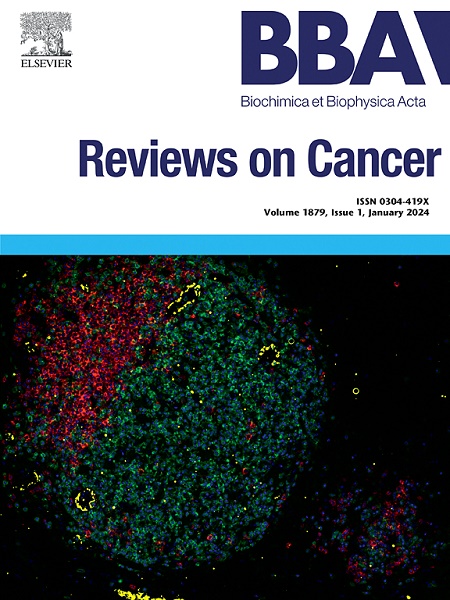TXNIP在癌症:解锁生物学见解和解决临床挑战。
IF 9.7
1区 医学
Q1 BIOCHEMISTRY & MOLECULAR BIOLOGY
Biochimica et biophysica acta. Reviews on cancer
Pub Date : 2025-07-18
DOI:10.1016/j.bbcan.2025.189394
引用次数: 0
摘要
癌症仍然是一项重大的全球健康挑战,也是全世界死亡的主要原因之一。它的发生和发展涉及复杂的遗传和分子改变,包括致癌基因的激活,以及肿瘤抑制基因(TSGs)的失活。这些tsg在调节细胞周期、基因组稳定性和凋亡途径中发挥关键作用,其功能障碍广泛影响肿瘤发生和治疗反应。在tsg中,硫氧还蛋白相互作用蛋白(TXNIP)作为一个在癌症生物学中具有多方面作用的关键调控因子而受到关注。机制研究已经确定TXNIP是一种广泛作用的蛋白,参与多种细胞反应,包括氧化应激、代谢、免疫调节和肿瘤抑制。这篇文献综述严格审查了TXNIP在癌症中功能的新临床和实验证据,特别关注乳腺癌,这是女性中最常见的恶性肿瘤。此外,它还探索了旨在恢复TXNIP肿瘤抑制功能以减缓癌症进展和改善患者预后的有希望的治疗进展。本文章由计算机程序翻译,如有差异,请以英文原文为准。
TXNIP in cancer: Unlocking biological insights and tackling clinical challenges
Cancer remains a major global health challenge and one of the leading causes of mortality worldwide. Its development and progression involve complex genetic and molecular alterations, including the activation of oncogenes, as well as the inactivation of tumor suppressor genes (TSGs). These TSGs play critical roles in regulating cell cycle, genomic stability, and apoptotic pathways, with their dysfunction widely contributing to tumorigenesis and therapy response. Among the TSGs, Thioredoxin Interacting Protein (TXNIP) has gained attention as a key regulator with multifaceted roles in cancer biology. Mechanistic insights have identified TXNIP as a broad-acting protein involved in a variety of cellular responses, including oxidative stress, metabolism, immune regulation, and tumor suppression. This literature review critically examines the emerging clinical and experimental evidence of TXNIP’s functions in cancer, with a particular focus on breast cancer, the most frequently diagnosed malignancy in women. Furthermore, it explores promising therapeutic advances aimed at restoring TXNIP tumor-suppressive functions to slow cancer progression and improving patient outcomes.
求助全文
通过发布文献求助,成功后即可免费获取论文全文。
去求助
来源期刊

Biochimica et biophysica acta. Reviews on cancer
医学-生化与分子生物学
CiteScore
17.20
自引率
0.00%
发文量
138
审稿时长
33 days
期刊介绍:
Biochimica et Biophysica Acta (BBA) - Reviews on Cancer encompasses the entirety of cancer biology and biochemistry, emphasizing oncogenes and tumor suppressor genes, growth-related cell cycle control signaling, carcinogenesis mechanisms, cell transformation, immunologic control mechanisms, genetics of human (mammalian) cancer, control of cell proliferation, genetic and molecular control of organismic development, rational anti-tumor drug design. It publishes mini-reviews and full reviews.
 求助内容:
求助内容: 应助结果提醒方式:
应助结果提醒方式:


